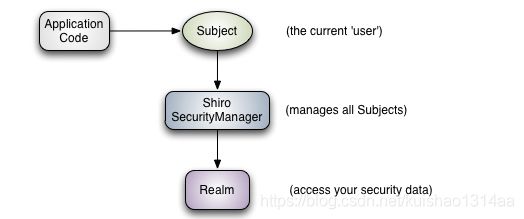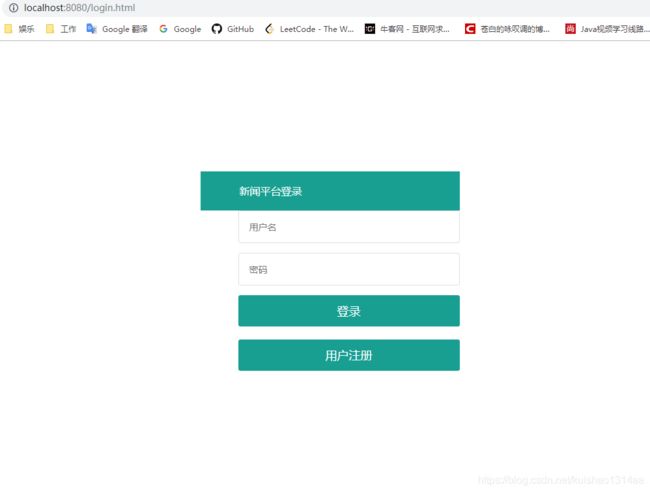Shiro安全框架的使用
Shiro安全框架
1.介绍
Shiro有三个核心的概念:Subject、SecurityManager和Realms。
Subject(主体): subject本质上是当前正在执行的用户的特定于安全的“view”。它也可以表示第三方服务、守护进程帐户、cron作业或任何类似的东西——基本上是当前与软件交互的任何东西。
SecurityManager(安全管理器): SecurityManager是Shiro架构的核心,它充当一种“伞形”对象,协调其内部安全组件,这些组件一起构成一个对象图,一旦为应用程序配置了SecurityManager及其内部对象图,通常就不需要再管它了,应用程序开发人员几乎将所有时间都花在Subject API上
Realms(领域): realm充当Shiro和应用程序的安全数据之间的“桥梁”或“连接器”。 当需要与与安全相关的数据(如用户帐户)进行实际交互以执行身份验证(登录)和授权(访问控制)时,Shiro会从一个或多个为应用程序配置的Realms中查找这些内容.类似于SpringMVC的DAO层
2.导入架包
在pom.xml中导入架包,使用SpringBoot来使用Shiro,采用的版本是
org.apache.shiro
shiro-core
${shiro.version}
org.apache.shiro
shiro-spring
${shiro.version}
org.apache.shiro
shiro-ehcache
${shiro.version}
3.编写Shiro配置文件
package com.example.demo.config;
import org.apache.shiro.authc.credential.HashedCredentialsMatcher;
import org.apache.shiro.cache.ehcache.EhCacheManager;
import org.apache.shiro.mgt.SecurityManager;
import org.apache.shiro.spring.LifecycleBeanPostProcessor;
import org.apache.shiro.spring.web.ShiroFilterFactoryBean;
import org.apache.shiro.web.filter.authc.LogoutFilter;
import org.apache.shiro.web.mgt.DefaultWebSecurityManager;
import org.springframework.context.annotation.Bean;
import org.springframework.context.annotation.Configuration;
import java.util.LinkedHashMap;
import java.util.Map;
@Configuration
public class ShiroConfiguration {
/**管理Shiro的生命周期*/
@Bean(name = "lifecycleBeanPostProcessor")
public static LifecycleBeanPostProcessor getLifecycleBeanPostProcessor(){
return new LifecycleBeanPostProcessor();
}
/**处理拦截请求,需要注入securityManager*/
@Bean(name = "shiroFilter")
public ShiroFilterFactoryBean shiroFilter(SecurityManager securityManager){
System.out.println("处理拦截请求");
ShiroFilterFactoryBean shiroFilterFactoryBean=new ShiroFilterFactoryBean();
/*用工厂*/
shiroFilterFactoryBean.setSecurityManager(securityManager);
/*默认跳转界面*/
shiroFilterFactoryBean.setLoginUrl("/login.html");
/*登录成功后跳转界面*/
shiroFilterFactoryBean.setSuccessUrl("/index.html");
/*跳转到未授权界面*/
shiroFilterFactoryBean.setUnauthorizedUrl("/test.html");
/*自定义拦截器,拦截动作次序与编写时顺序有关,确保最后进行'/**'的验证操作,否则他之后的会拦截失效*/
Map filterChainDefinitionMap = new LinkedHashMap();
//设置不需要访问权限的界面,Resource和Controller访问目录为'/'
filterChainDefinitionMap.put("/login", "anon");
filterChainDefinitionMap.put("/demo/test", "anon");
filterChainDefinitionMap.put("/js/**", "anon");
filterChainDefinitionMap.put("/css/**", "anon");
//对所有的用户进行认证,'authc'代表需要登录,当所有的认证都通过的时候才可以访问路径,
filterChainDefinitionMap.put("/**", "authc");
//退出拦截器,并对退出动作进行重定向
filterChainDefinitionMap.put("/logout", "logout");
LogoutFilter logoutFilter = new LogoutFilter();
logoutFilter.setRedirectUrl("/login.html");
//将自定义拦截器放入'shiroFilter'拦截器中
shiroFilterFactoryBean.getFilters().put("logout", logoutFilter);
shiroFilterFactoryBean.setFilterChainDefinitionMap(filterChainDefinitionMap);
return shiroFilterFactoryBean;
}
@Bean(name = "securityManager")
public SecurityManager securityManager(EhCacheManager cacheManager) {
DefaultWebSecurityManager securityManager = new DefaultWebSecurityManager();
//设置自己编写的Realm,进行认证和授权操作
securityManager.setRealm(myShiroRealm());
securityManager.setCacheManager(cacheManager);
return securityManager;
}
/**设置自己编写的Realm,进行认证和授权操作,'MyShiroRealm'要另外编写,
* 进行认证和授权时会自动调用realm中的方法*/
@Bean
public MyShiroRealm myShiroRealm() {
MyShiroRealm myShiroRealm = new MyShiroRealm();
myShiroRealm.setCredentialsMatcher(hashedCredentialsMatcher());
return myShiroRealm;
}
/**
* 凭证匹配器 (由于我们的密码校验交给Shiro的SimpleAuthenticationInfo进行处理了
* 进行的加密操作
*/
@Bean
public HashedCredentialsMatcher hashedCredentialsMatcher() {
HashedCredentialsMatcher hashedCredentialsMatcher = new HashedCredentialsMatcher();
hashedCredentialsMatcher.setHashAlgorithmName("md5");// 散列算法:这里使用MD5算法;
hashedCredentialsMatcher.setHashIterations(2);// 散列的次数,比如散列两次,相当于
// md5(md5(""));
return hashedCredentialsMatcher;
}
/**配置缓存*/
@Bean
public EhCacheManager getCacheManager(){
EhCacheManager ehCacheManager = new EhCacheManager();
ehCacheManager.setCacheManagerConfigFile("classpath:ehcache.xml");
return ehCacheManager;
}
}
4.缓存配置
5.自定义Realm
在Shiro中,进行的授权和认证就是由它来操作的,认证操作时在登录时通过Subject的login方法,将用户名密码传入这里面,与数据里面进行交互,判断是否存在此用户或者密码是否正确,存在则认证成功,主要有两个方法
package com.example.demo.config;
import com.example.demo.pojo.User;
import com.example.demo.service.UserService;
import com.example.demo.utils.UserUtils;
import org.apache.shiro.authc.*;
import org.apache.shiro.authz.AuthorizationInfo;
import org.apache.shiro.authz.SimpleAuthorizationInfo;
import org.apache.shiro.realm.AuthorizingRealm;
import org.apache.shiro.subject.PrincipalCollection;
import org.apache.shiro.subject.SimplePrincipalCollection;
import org.apache.shiro.util.ByteSource;
import org.slf4j.Logger;
import org.slf4j.LoggerFactory;
import org.springframework.beans.factory.annotation.Autowired;
import org.springframework.context.annotation.Configuration;
import org.springframework.util.StringUtils;
import javax.annotation.Resource;
import java.util.HashSet;
import java.util.List;
import java.util.Set;
import java.util.stream.Collectors;
@Configuration
public class MyShiroRealm extends AuthorizingRealm {
@Autowired
private UserService userService;
/*只有需要验证权限时才会调用, 授权查询回调函数, 进行鉴权但缓存中无用户的授权信息时调用.在配有*缓存的情况下加载.
* 如果需要动态权限,但是又不想每次去数据库校验,可以存在ehcache中.自行完善*/
@Override
protected AuthorizationInfo doGetAuthorizationInfo(PrincipalCollection principalCollection) {
log.debug("权限配置");
SimpleAuthorizationInfo authorizationInfo = new SimpleAuthorizationInfo();
//获取当前用户
User user = UserUtils.getCurrentUser();
System.out.println(user.toString());
//设置权限
Set roles = new HashSet<>();
roles.add(String.valueOf(user.getRoleId()));
authorizationInfo.setRoles(roles);
return authorizationInfo;
}
/* * 认证回调函数,调用Subject的login()方法时访问到这一层
* 首先根据传入的用户名获取User信息;然后如果user为空,那么抛出没找到帐号异常UnknownAccountException;
* 如果不匹配将抛出密码错误异常UnknownAccountException;
* 在组装SimpleAuthenticationInfo信息时, 需要传入:身份信息(用户名)、凭据(密文密码)、盐(username+salt),
* CredentialsMatcher使用盐加密传入的明文密码和此处的密文密码进行匹配。
* */
@Override
protected AuthenticationInfo doGetAuthenticationInfo(AuthenticationToken authenticationToken) throws AuthenticationException {
UsernamePasswordToken token = (UsernamePasswordToken) authenticationToken;
String name=token.getUsername();
System.out.println("name:"+name);
User user = userService.getUserByname(token.getUsername());
/*加密后的密码*/
String encoderPassword=userService.EncoderPassword(new String(token.getPassword()),user.getSalt());
System.out.println(user.getName()+" "+encoderPassword);
if (user == null) {
throw new UnknownAccountException("用户名不存在");
}
if (userService.getUser(user.getName(),encoderPassword)==null)
{
throw new UnknownAccountException("密码不正确");
}
/*通过验证条件*/
SimpleAuthenticationInfo authenticationInfo = new SimpleAuthenticationInfo(user, user.getPassword(),
ByteSource.Util.bytes(user.getSalt()), getName());
/*设置当前用户的session*/
UserUtils.setUserSession(user);
return authenticationInfo;
}
/**
* 重写缓存key,否则集群下session共享时,会重复执行doGetAuthorizationInfo权限配置
*/
@Override
protected Object getAuthorizationCacheKey(PrincipalCollection principals) {
SimplePrincipalCollection principalCollection = (SimplePrincipalCollection) principals;
Object object = principalCollection.getPrimaryPrincipal();
if(object instanceof User){
User user = (User) object;
return "authorization:cache:key:users:" + user.getId();
}
return super.getAuthorizationCacheKey(principals);
}
}
编写一个工具类,来获取当前的user或者session
package com.example.demo.utils;
import com.example.demo.pojo.User;
import org.apache.shiro.SecurityUtils;
import org.apache.shiro.session.Session;
import org.apache.shiro.subject.Subject;
public class UserUtils {
private static String login_user="login_user";
public static void setUserSession(User user) {
getSession().setAttribute(login_user, user);
}
public static Session getSession() {
Subject currentUser = SecurityUtils.getSubject();
Session session = currentUser.getSession();
return session;
}
public static User getCurrentUser() {
User user = (User) getSession().getAttribute(login_user);
return user;
}
}
6.加密算法和获取Session的方法
加密算法在Shiro配置文件中使用的是MD5,加密两次,相应的login认证操作调用EncoderPassword() 方法时,两者也应该一样
在Service中编写登录认证的加密算法,这样登录认证时的加密后的密码和数据库中对应的一致
@Override
public String EncoderPassword(String password, String salt) {
//采取MD5算法进行加密,加密2次
Object object = new SimpleHash("MD5", password, salt, 2);
return object.toString();
}7.登录操作
获取到前端的用户名和密码,封装在一个token里面,然后获取当前的subject,调用它的login方法,参数传入,然后它会调用到自定义realm中的认证操作,认证成功后返回数据
@RestController
@RequestMapping(value = "/demo")
public class DemoController {
@RequestMapping("/test")
public User index(User user) {
//用于存取用户名和密码
UsernamePasswordToken usernamePasswordToken = new UsernamePasswordToken(user.getName(), user.getPassword());
//设置一个subject
Subject subject =SecurityUtils.getSubject();
/*对这个subject对应的用户名和密码进行认证操作,若自己自定义了realm,会用自定义的realm记性*/
subject.login(usernamePasswordToken);
User user2=UserUtils.getCurrentUser();
System.out.println(UserUtils.getCurrentUser().toString());
return user2;
}
}
8.授权操作
在realm中doGetAuthorizationInfo()中编写,为认证后的用户添加角色控制,在controller中或其他地方设置访问权限,只有拥有权限的用户方可进行相关操作,如下所示:
数据库中角色定位2,那么只有
@RequestMapping("/role")
//@RequiresAuthentication:只要授权就能就能进行访问
@RequiresRoles(value = {"2","user"},logical = Logical.OR) //只要其中一个角色进行了进行了认证就行
public String Role(){
Sysem.out.println("测试角色");
return "regist.html";
}9.测试结果
登录界面,默认跳转界面
认证成功
点击测试角色,动作为"/role"




